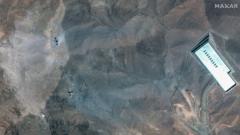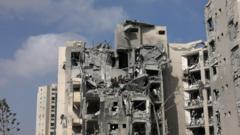In a matter of hours, the geopolitical landscape shifted dangerously, revealing vulnerabilities and triggering diplomatic efforts that aimed to restore peace.
**Tensions Eased: How a Chaotic Day Led to an Unexpected Ceasefire in the Middle East**

**Tensions Eased: How a Chaotic Day Led to an Unexpected Ceasefire in the Middle East**
A whirlwind of military strikes, threats, and urgent talks culminated in a fragile ceasefire agreement between Iran and Israel following a series of violent escalations.
As the conflict between Iran and Israel continued to escalate, a tense 24-hour period sparked urgent diplomatic discussions leading to an unexpected ceasefire. Following intense military strikes against Iranian targets, a series of developments unfolded swiftly, with the US actively mediating between the two nations.
The chain of events began when the US government advised its citizens in Qatar to "shelter in place," a precautionary measure signaling potential Iranian retaliation against US presence at the al-Udeid airbase. Tensions escalated as missile launchers were identified, prompting immediate air traffic restrictions in the region. As explosions shook the skies close to Doha, Iranian authorities affirmed that their retaliation had commenced, showcasing defiance against what they termed "brazen aggression" from the US.
Despite the alarming missile launches, the situation took a diplomatic turn as US President Donald Trump publicly extended a conciliatory gesture towards Iran, thanking them for prior warnings and proposing a path toward "Peace and Harmony in the Region." This unexpected tone marked a stark contrast to earlier military rhetoric, hinting at potential de-escalation just as tensions peaked.
Behind the scenes, frantic communications took place between US, Iranian, and Israeli officials, with the objective of forging a ceasefire agreement. As reports of discussions grew, Trump publicly announced that a ceasefire had been struck, coining the conflict as the "12 Day War." Although skepticism lingered, the formal acceptance of ceasefire conditions by both Iran and Israel appeared imminent.
However, the fragile agreement faced immediate threats, as missile alerts rang across Israel amidst reports of incoming Iranian strikes. The military actions left casualties, underscoring the volatility of the situation. Yet, calls for compliance emerged swiftly from the US, with Trump urging restraint from both sides following clashes that nearly undermined the ceasefire.
In a stark illustration of the complexities of Middle Eastern politics, the ceasefire's stability remains uncertain. With military actions carried out until the last moments before the ceasefire's official commencement, broader tensions highlighted the need for ongoing dialogue. As confusion continues, the world observes closely, awaiting developments that could either stabilize or further fracture the region.
The chain of events began when the US government advised its citizens in Qatar to "shelter in place," a precautionary measure signaling potential Iranian retaliation against US presence at the al-Udeid airbase. Tensions escalated as missile launchers were identified, prompting immediate air traffic restrictions in the region. As explosions shook the skies close to Doha, Iranian authorities affirmed that their retaliation had commenced, showcasing defiance against what they termed "brazen aggression" from the US.
Despite the alarming missile launches, the situation took a diplomatic turn as US President Donald Trump publicly extended a conciliatory gesture towards Iran, thanking them for prior warnings and proposing a path toward "Peace and Harmony in the Region." This unexpected tone marked a stark contrast to earlier military rhetoric, hinting at potential de-escalation just as tensions peaked.
Behind the scenes, frantic communications took place between US, Iranian, and Israeli officials, with the objective of forging a ceasefire agreement. As reports of discussions grew, Trump publicly announced that a ceasefire had been struck, coining the conflict as the "12 Day War." Although skepticism lingered, the formal acceptance of ceasefire conditions by both Iran and Israel appeared imminent.
However, the fragile agreement faced immediate threats, as missile alerts rang across Israel amidst reports of incoming Iranian strikes. The military actions left casualties, underscoring the volatility of the situation. Yet, calls for compliance emerged swiftly from the US, with Trump urging restraint from both sides following clashes that nearly undermined the ceasefire.
In a stark illustration of the complexities of Middle Eastern politics, the ceasefire's stability remains uncertain. With military actions carried out until the last moments before the ceasefire's official commencement, broader tensions highlighted the need for ongoing dialogue. As confusion continues, the world observes closely, awaiting developments that could either stabilize or further fracture the region.























